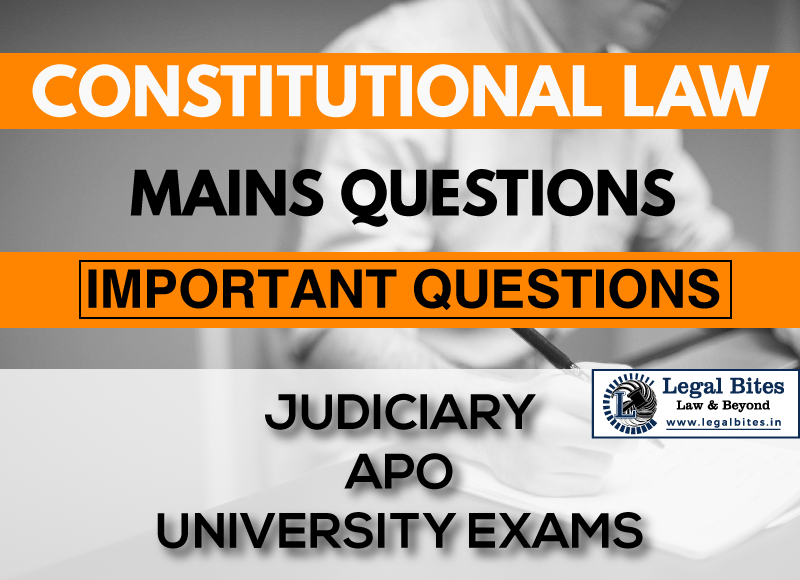Explain the rule of severability with reference to clauses (1) and (2) of Article 13 of the Constitution. Eight sections of the Bombay Prohibition Act, 1949....ultra vires on the ground............?
Find the answer to the mains question of Constitutional Law only on Legal Bites.

Question: Explain the rule of severability with reference to clauses (1) and (2) of Article 13 of the Constitution. Eight sections of the Bombay Prohibition Act, 1949 were declared ultra vires on the ground that they infringed the Fundamental Rights of citizens. Can the rest of the Act survive? [UPJS 2012] Find the answer to the mains question only on Legal Bites.[Explain the rule of severability with reference to clauses (1) and (2) of Article 13 of the Constitution. Eight sections of...
Question: Explain the rule of severability with reference to clauses (1) and (2) of Article 13 of the Constitution. Eight sections of the Bombay Prohibition Act, 1949 were declared ultra vires on the ground that they infringed the Fundamental Rights of citizens. Can the rest of the Act survive? [UPJS 2012]
Find the answer to the mains question only on Legal Bites.[Explain the rule of severability with reference to clauses (1) and (2) of Article 13 of the Constitution. Eight sections of the Bombay Prohibition Act, 1949 were declared ultra vires on the ground that they infringed the Fundamental Rights of citizens. Can the rest of the Act survive?]
Answer
The Fundamental Rights enshrined in the Constitution guarantee every citizen a life of dignity, liberty, and holistic development. Any law infringing upon these rights is liable to be struck down by the courts. The doctrine of severability addresses such situations and determines the extent to which an unconstitutional provision impacts the validity of the rest of the statute.
The doctrine of severability, rooted in Article 13(1) and (2) of the Constitution, provides that if certain provisions of a statute violate Fundamental Rights but can be severed from the remaining valid portions, then only the offending provisions will be declared void. The remaining provisions, if independent and consistent with the intent of the legislation, will continue to be valid and enforceable.
- Article 13(1) declares that pre-constitutional laws inconsistent with Fundamental Rights shall be void to the extent of such inconsistency.
- Article 13(2) prohibits the State from making post-constitutional laws that infringe upon Fundamental Rights, rendering such laws void ab initio.
These provisions uphold the primacy of Fundamental Rights and empower the courts to scrutinize laws through judicial review.
Application of Severability
When only certain portions of a statute are unconstitutional, courts apply the doctrine of severability to preserve the valid portions. Key principles for applying severability were elaborated in R.M.D.C. v. State of Bombay (1957):
- Legislative Intent: The intention of the legislature is pivotal. If the legislature intended the law to function independently without the unconstitutional parts, the valid parts may survive.
- Independent Existence: If the valid portions can stand independently and fulfill the legislative intent, they will be upheld.
- Interdependence: If the valid and invalid portions are so intertwined that they cannot be separated, the entire statute will be invalidated.
- Effect on the Statute: If severing the invalid provisions leaves the rest of the statute ineffective or incomplete, the entire law will be struck down.
- Contextual Analysis: The statute is analyzed as a whole, considering its preamble, title, history, and objectives, to determine severability.
In State of Bombay v. F.N. Balsara (1951), the Supreme Court applied the doctrine of severability to the Bombay Prohibition Act, 1949, where eight sections were declared unconstitutional for violating Fundamental Rights. The Court held that the invalid sections did not affect the validity of the remaining provisions, which were separable and consistent with the legislative intent. Thus, the rest of the Act survived.
The doctrine of severability ensures that only the unconstitutional portions of a statute are struck down, preserving the rest if they are independent and enforceable. In the context of the Bombay Prohibition Act, 1949, the remaining provisions could survive after severing the invalid sections, provided they complied with the principles of severability and legislative intent.
Important Mains Questions Series for Judiciary, APO & University Exams
- Constitutional Law Mains Questions Series Part-I
- Constitutional Law Mains Questions Series Part-I
- Constitutional Law Mains Questions Series Part-II
- Constitutional Law Mains Questions Series Part-IV
- Constitutional Law Mains Questions Series Part-V
- Constitutional Law Mains Questions Series Part-VI
- Constitutional Law Mains Questions Series Part-VII
- Constitutional Law Mains Questions Series Part-VIII
- Constitutional Law Mains Questions Series Part-IX
- Constitutional Law Mains Questions Series Part-X
Admin Legal Bites
Legal Bites Study Materials correspond to what is taught in law schools and what is tested in competitive exams. It pledges to offer a competitive advantage, prepare for tests, and save a lot of money.

